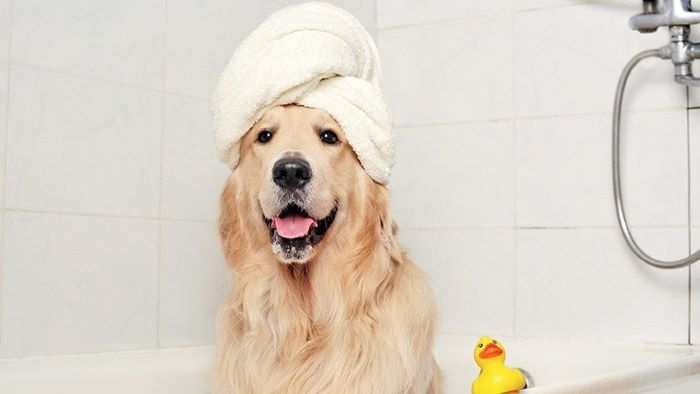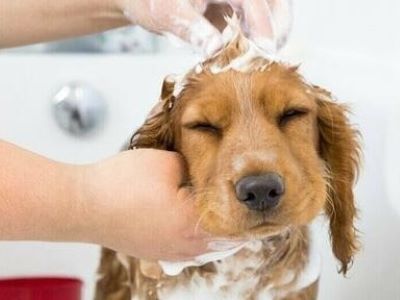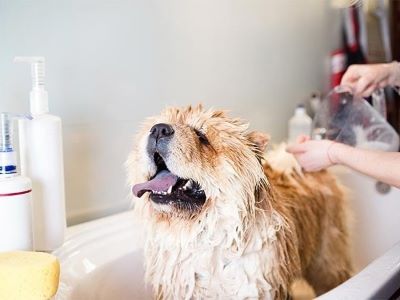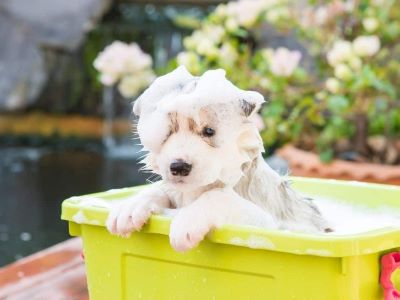Curious about giving your dog a bath? Let’s take it further and explore, “How to give a dog🐶 a bath in the tub?”

We’ve got the answers in this guide, making it easy and fun. So, let’s get started on the path to a clean and happy pup!🫧
How to Give a Dog a Bath in the Tub?
Giving your dog regular baths is an important part of pet grooming and care🪥. Bathing helps keep your dog’s coat clean, and free of dirt, debris, and parasites.
Depending on the breed, lifestyle and environment, dogs may need baths ranging from every 2-3 months⌛ to once a week[1]. Let’s see what supplies you’ll need to give your dog a bath:
| Supplies | Purpose |
|---|---|
| Dog shampoo | Avoid skin irritation |
| Towels | Dry dog after a bath🛁 |
| Dog brush | Remove tangles pre-bath |
| Treats🍭 | Reward good behavior |
| Non-slip tub mat | Prevent slipping |
1. Preparing the Tub
It’s crucial to make sure the bathtub is squeaky clean.
- Remove any dirt, hair, or soap residue from previous baths. This cleanliness not only makes for a more pleasant bathing environment but also reduces the chance of any skin irritations or infections.🧫
- Dogs are not known for their aquatic grace, so it’s essential to create a secure footing for them. Lay down a non-slip mat or even an old towel inside the tub, this will prevent any potential accidents caused by slipping.
- Aim for lukewarm water, around body temperature (around 37°C or 98. 6°F). Use your wrist or elbow to check the water’s temperature, as it’s more sensitive than your fingers.

Water that is too hot can scald your dog, while water that is too cold❄️ can be uncomfortable.
2. Preparing the Dog
Brushing not only removes tangles and mats but also spreads natural oils for a healthy, shiny coat. It’s a soothing routine and prepares the skin for a more effective bath.🛁
Check your dog’s ears for redness, inflammation, or excess wax, and examine their eyes for any discharge or redness. Also, inspect their paws for cuts or foreign objects. Trim long nails before bathing using a dog-specific nail trimmer, and be careful not to cut too close.
If unsure, consult a professional groomer. Reward good behaviour during the bath with treats and praise for a more positive bath experience in the future.
"If your dog hates water or is anxious about baths, check out our tips on how to bath a dog that hates water."
“Bathing can have many health benefits like removing dirt and odours from the skin and coat, it is also necessary to heal inflamed or infected skin and damaged hair“, says the experts at Paws & Claws Animal Hospital.🏥
3. Bathing Your Dog
Encourage your dog to enter the tub calmly and confidently, and use treats and gentle words to reassure them if they’re anxious.
- Avoid sudden movements or loud noises that might scare your pet. Wet your dog’s coat evenly using a handheld showerhead or a jug of lukewarm water, starting at the neck and moving down towards the tail.
- Ensure thorough wetting to help the shampoo lather and spread effectively. Use a dog-specific shampoo to prevent skin irritation.

- Apply a small amount of shampoo to your hands and lather it gently, starting at the neck and moving towards the tail, be cautious around the eyes and ears.
- Rinse your dog thoroughly, using the showerhead or jug, until the water runs clear, make sure to rinse all areas, including the belly, legs, and paws, to avoid soap residue.🐕
- For sensitive facial areas, dampen a cloth or sponge with lukewarm water and gently wipe your dog’s face, avoiding the eyes and ears.
- If your dog’s ears appear dirty or smell unusual, consider cleaning them with a veterinarian-approved ear cleaner, following the product instructions carefully.
After cleaning the face and ears, give your dog’s entire coat one final rinse, paying attention to areas where shampoo might linger, such as under the tail or on the legs, to prevent skin irritation and maintain a soft, clean coat.
If bathing your dog in the tub is difficult, consider using a portable dog washer for more convenient bathing on-the-go.
4. Drying Your Dog
After the bath, gently pat your dog’s coat with clean towels[2]. Begin at the head and work your way towards the tail. Patience is key🗝️ during this process. Avoid vigorous rubbing, as it can lead to tangles, especially if your dog has long or curly hair.
After toweling, you may choose to place your dog in a dog drying bag to help absorb moisture and quicken the drying process.
If your dog is comfortable with the noise and sensation, you can use a hairdryer on a low, cool setting to speed up the drying process. Keep the dryer at a safe distance and move it continuously to prevent overheating.
Ensure it’s a positive experience for your dog. Make sure your dog is thoroughly dry, especially during colder weather, to prevent them from getting chilled. A completely dry coat helps maintain your dog’s warmth and comfort

5. Post-Bath Care
After the bath, it’s time to show your appreciation.
- Reward your dog with praise👏 and tasty treats🍬 for their cooperation and calmness. This reinforces the idea that bath time is a good experience and can make future baths more manageable.
- Once your dog is dry, take a moment to brush their coat once more. It also promotes healthy fur growth and distributes natural oils, making their coat shiny and comfortable.
- Clean the tub, removing any remaining soap residue or dog hair. Proper cleaning helps maintain hygiene and ensures a pleasant experience for the next bath.
If you've recently applied a flea treatment to your dog, hold off on bathing for at least 2 days. For more tips check out our guide on how long after flea treatment can i bathe my dog?
FAQs
❓Can I Bathe My Dog Every Day?
Most vets advise against washing your dog every day unless your pet’s health practitioner recommends otherwise. Bathing your dog too frequently can irritate your four-legged friend’s skin and dry out their coat. Only wash your dog every day if they have a health condition, and your veterinarian advises daily washes.
❓What No to When Bathing a Dog?
Don’t pour water over your dog’s head because lots of dogs develop secondary ear infections from moisture getting into the ear canal. 3. Don’t get your dirty dog a “little bit” wet – If you don’t have a hose or sprayer, just fill up the bath and slowly pour the water over your dog, saturating the coat and skin.
❓How Do You Give a Bath to a Dog Without Putting Them Into a Bathtub?
The Sink Bath Method: Make sure the water is warm, not too hot and not too cold. Put the cotton balls just inside your pup’s ears to keep water out. Add your dog to the sink and use the cup to pour warm water over him to wet him down. Apply a small amount of shampoo to your hands and lather onto your little dog.
Conclusion
Just as we humans need regular showers, our dogs benefit from bath time too. Bathing your dog helps remove dirt, odours, and allergens, promoting their cleanliness and well-being.💖
It’s an essential part of responsible pet ownership. Remember, even the most reluctant bath-taker can become a bath enthusiast with the right approach. By following the steps outlined in this guide and using plenty of treats and praise, you can turn bath time into a bonding experience.
So, the next time someone asks, “How to give a dog a bath in the tub?” you’ll be well-prepared to ensure that it’s a bubbly, enjoyable adventure for both you and your canine companion. Happy bathing!🐶🛁
Be sure to follow your vet's advice on how long after being neutered can a dog have a bath. Avoiding the incision area until it is fully healed is key to your pup's recovery.
Reference:
- Lotz, K. (2023). How often should you bathe your dog? American Kennel Club.
- Insurance, A. P. (2016b, July 25). How to give a dog a bath. ASPCA Pet Health Insurance.



